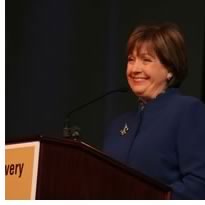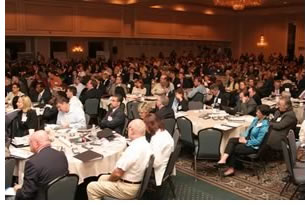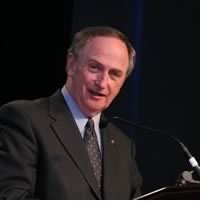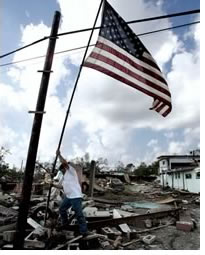

12/2005
AIA-sponsored conference allows citizens’ voices to define rebuilding
 The
Louisiana Recovery Authority board of directors at its December 1 meeting
in Baton Rouge voted unanimously to accept a motion to endorse the “goals
and principles for action” set forth by the 650 people who took
part at the AIA-sponsored Louisiana Recovery and Rebuilding Conference
last month. These goals and principles define the framework for the next
steps in the rebuilding of the greater New Orleans metropolitan region
and the entire southern Louisiana Gulf Coast region that were devastated
in September by Hurricanes Katrina and Rita.
The
Louisiana Recovery Authority board of directors at its December 1 meeting
in Baton Rouge voted unanimously to accept a motion to endorse the “goals
and principles for action” set forth by the 650 people who took
part at the AIA-sponsored Louisiana Recovery and Rebuilding Conference
last month. These goals and principles define the framework for the next
steps in the rebuilding of the greater New Orleans metropolitan region
and the entire southern Louisiana Gulf Coast region that were devastated
in September by Hurricanes Katrina and Rita.
Specifically, the motion, which was proposed by the LRA’s Long-Term Community Planning Task Force Chair Donna Fraiche, says, “Now, therefore, be it resolved, that the Louisiana Recovery Authority does hereby endorse the AIA/APA goals and planning principles as outlined in Starting Point: Report from the Louisiana Recovery and Rebuilding Conference, within the section titled, ‘Goals and Principles for Action.’”
“It was a privilege to deliver the results of the conference to the Louisiana Recovery Authority’s board,” said David Downey, Assoc. AIA, managing director of the Institute’s Center for Communities by Design. “Trula Remson, AIA, and Steve Villavaso, AICP, were able to present the LRA with copies of Starting Point and offer them DVDs showing conference highlights and the participants hard at work. Most rewarding was hearing the LRA Board profess their dedication to speaking with one voice and rebuilding communities or neighborhoods rather than simply looking for development options. It was rewarding because this was the language used by the conference participants two weeks prior.”
 Citizens’ conference created framework
Citizens’ conference created framework
The November 10–12 Louisiana Recovery and Rebuilding Conference
in New Orleans, presented by the AIA in collaboration with the American
Planning Association and cosponsored by the National Trust for Historic
Preservation and the American Society of Civil Engineers at the request
of Louisiana Governor Kathleen Blanco and the Louisiana Recovery Authority,
provided the forum through which participants could all have their voices
heard. Architects, planners, public officials, business people, community
leaders and citizens worked together for an intense three days to hammer
out a body of planning principles they want to guide the state’s
long-range recovery efforts. These goals and principles, now endorsed
by the LRA, are:
1. Create infrastructure that supports recovery by restoring confidence, enhancing quality of life, and withstanding future disasters by:
- Category 5 protection—levees, restored wetlands, and an independent authority to ensure ongoing maintenance and funding
- Improved services including communications, energy, and other key elements
- Sustainable, equitable, and transparent approaches to rebuilding and future development.
2. Promote economic growth that benefits everyone through:
- A diverse economy encompassing traditional and emerging industries, supported by both respect for the region’s historic character and innovative funding strategies (incentives, and public/private partnerships)
- A foundation for growth including quality education and job training, housing, transportation, and other key elements available regardless of income
- Equity that includes living wages and career tracks, benefits everyone in the region, and provides long-term economic opportunity.
 3. Provide public services that
enhance quality of life for everyone through:
3. Provide public services that
enhance quality of life for everyone through:
- High quality education at every level as the center for rebuilding communities
- Regional transit, coordinated with opportunities for community development
- Great parks and other public spaces that serve communities and support flood control.
4. Pursue policies that promote a healthy environment and healthy
people by:
- Deciding where to rebuild, investing in protecting these areas, and dedicating remaining areas to natural uses
- Sustainable approaches to every facet of rebuilding—energy, transit, land use, building design, and other elements
- Walkable communities that, through their planning and design, promote healthy lifestyles.
5. Plan and design communities that advance livability by:
- Preserving the best of the past as the core for rebuilding while anticipating future needs
- Mixed-income, mixed-use neighborhoods that foster diversity and social equity
- Smart growth at an urban, suburban, and rural scale that balances recovery and sustainability.
 “I
was struck by the determination of those present to bring New Orleans
and Louisiana back. You cannot imagine a more diverse gathering of people
than those who attended the conference,” concluded AIA Executive Vice
President/CEO Norman L. Koonce, FAIA, who offered opening remarks at
the conference. “They may have debated what it would take and
what needed to be done to move forward, but they were of one voice in
visioning a common goal—rebirth. And they were of one spirit in
believing that the vision was theirs to achieve. The AIA was in New Orleans
to bear witness to that spirit and cheer it on.”
“I
was struck by the determination of those present to bring New Orleans
and Louisiana back. You cannot imagine a more diverse gathering of people
than those who attended the conference,” concluded AIA Executive Vice
President/CEO Norman L. Koonce, FAIA, who offered opening remarks at
the conference. “They may have debated what it would take and
what needed to be done to move forward, but they were of one voice in
visioning a common goal—rebirth. And they were of one spirit in
believing that the vision was theirs to achieve. The AIA was in New Orleans
to bear witness to that spirit and cheer it on.”
“Cheer it on:” Next steps
to a long-range plan
Having adopted the LRRC’s planning principles as a starting platform
for the rebuilding of the region, the Louisiana Recovery Authority board
also adopted the LRA’s Long-Range Planning Committee’s
recommendation to establish a nationally recognized community planning
team composed of:
- Calthorpe Associates for a long-term regional vision
- Urban Design Associates and additional firms for planning and architectural standards and tools
- Duany Plater-Zyberk Associates for coordination of voluntary local design charrettes.
The LRA Support Organization—a nonprofit foundation made up of Board members from the Baton Rouge Area Foundation, the Greater New Orleans Foundation, and the LRA—implemented the LRA’s guideline for selection of design professionals, which will include architects and planners from the Louisiana Gulf region, Fraiche says. “It is essential that the local communities get the opportunity to participate in their own planning effort. This has to be a groundswell approach from the bottom up,” she says. She notes that Trula Remson, AIA, president of AIA Louisiana, is integral to this process as a member of the LRA Long-Term Community Planning Task Force.
The planning team has been charged to assess recovery needs through a series of meetings within parishes. The advisory group’s first order of business was to recruit experienced volunteer professionals to facilitate the first round of parish planning meetings currently scheduled for January 6–11, 2006.
 Calthorpe
is the coordinator of the planning and design team to make sure all of
the parts of the effort are consistent with the ultimate plan for the
entire state, explains Donna Fraiche, who chairs the LRA Long-Term Community
Planning Task Force. “The planning team’s
jurisdiction will go from southwest Louisiana border all the way to
the Mississippi coast, and the principals developed at the AIA/APA
conference are the starting point,” she said.
Calthorpe
is the coordinator of the planning and design team to make sure all of
the parts of the effort are consistent with the ultimate plan for the
entire state, explains Donna Fraiche, who chairs the LRA Long-Term Community
Planning Task Force. “The planning team’s
jurisdiction will go from southwest Louisiana border all the way to
the Mississippi coast, and the principals developed at the AIA/APA
conference are the starting point,” she said.
“We feel very enthusiastic that this process needs to be done
with a great deal of urgency,” Fraiche concludes. “But, at
the same time, it requires the kind of necessary thought, integration,
and stakeholder participation to get it done right. And I want to reiterate
what came out at the December 1 LRA Board meeting, which is nothing but
incredible gratitude for the effort of the AIA and APA in putting together
the Louisiana Recovery and Rebuilding Conference as a starting point.
It was extremely important to us to have the benefit of the national
and international expertise on the subject, not to mention the outpouring
of feelings and warmth, hard work, and desire to see this region rebuilt.
We have to thank the national efforts of your organizations for putting
that opportunity together. It brought a lot of minds and spirits together.
If we heard anything it is for us to do whatever we can to rebuild it
better, stronger, and wiser.”
 Overarching themes prevail
Overarching themes prevail
The December 1 meeting also presented an opportunity for the LRRC sponsors—represented
by AIA Louisiana President Trula Remson, AIA; American Planning Association
Louisiana President Steve Villavaso; and Downey—explain the principles
and describe the tenor of the conference. Specifically, Remson presented
the six overarching themes that tied together the participants’ three
days of discussions:
Unify. “You have said this all morning; it was said over and over at the conference, ‘Speak with one voice,’” Remson said. “We have all said it. We just must do it. “
Cooperate. Public and private sectors; parishes and municipalities; federal, state, and local governments must cooperate creatively and selflessly. “As I look at our State Seal that is hanging there on the back wall, I see a mother pelican in her nest with her babies. he is pecking the meat from her own breast to feed her babies,” Remson said. “Now, that is selfless. That is creative, and that is the kind of cooperation that the citizens of our state are expecting.”
Protect. Protection from floods, hurricanes, coastal erosion. “Our citizens must have protection in order to have the confidence to rebuild and to reinvest,” Remson said. “Think, again, of our Mother Pelican. Protect.”
Preserve. “There is so much right about Louisiana. We want to preserve and protect our heritage, our architecture, our culture, our diversity.”
Rebuild. “The citizens are ready to go and ready to rebuild. We need answers in a timely manner.”
 Improve. “We
must learn from the mistakes of the past while we look forward to rebuilding.”
Improve. “We
must learn from the mistakes of the past while we look forward to rebuilding.”
Remson also told the directors that the “Starting Point” report presents the needs defined by each individual parish as they worked in breakout sessions on the third day of the conference. Although each parish expressed very different needs, five ideas emerged in every group:
- Schools as quality of life issues and as economic development
- Transit to link neighborhoods to communities, communities to towns, towns to cities and link the cities together as a region
- Mixed-use/mixed-income neighborhoods to build diverse communities
- Planning regionally: We are stronger together
- Allowing everyone to participate. These discussions must be continued in a collaborative, transparent way.
Remson concluded, “The people of Louisiana are looking to you, the LRA, to bring back the Hope, the Confidence, and the Opportunity to Dream once again.”
Copyright 2005 The American Institute of Architects.
All rights reserved. Home Page ![]()
![]()
